22 Digital Business Trends for 2023

In this post, we explore digital business trends in strategy, design, technology, and marketing that could impact purpose-driven organizations over the coming year and beyond.
Chat GPT, increasing data privacy and digital accessibility lawsuits, more sophisticated website hacks, the continued spread of misinformation, etc.—the list of technology-related issues that could impact your organization this coming year and beyond is extensive.
Plus, digital trends change constantly. Many opportunities lie in adopting or evolving new business practices, learning new tools, and keeping team skills up-to-date.
Defining Digital Business Trends for the Coming Year
Our team looked into new products, technologies, legislation, and evolving practices to better understand trends that could impact our work with clients this coming year. There were a lot of them! We handpicked 22 rising and relevant topics.
We broke these digital business trends down to match the four categories of Mightybytes’ digital agency services:
Click any of the four links above for a deeper look into digital business trends related to that individual category. Otherwise, let’s dig in.
Digital Business Trends: Strategy
As a Certified B Corp, Mightybytes regularly reviews good business and marketing strategies for purpose-driven organizations. The best strategies are those that incorporate a forward-thinking approach to technology while also folding socially- and environmentally-responsible practices into everything an organization does.
Here are several digital business trends that could impact your organizational strategy in the year ahead.
1. Digital Sustainability
There’s a growing recognition of the impact of humans’ digital footprint on the environment.
— Wunderman Thompson Intelligence, The Future 100
2022 was a good year for digital sustainability. We saw more organizations across sectors include sustainability criteria as part of creative briefs, RFPs, and digital project plans. We also saw the U.N. Environment Programme (UNEP) launch its first digital sustainability course.
However, a lack of clear standards and best practices often leads to confusion around how, specifically, to implement and operationalize digital sustainability within an organization. In 2022, a community group within the World Wide Web Consortium (W3C) set out to more clearly define a set of best practices. Hopefully, in 2023, we’ll see even more schools, agencies, and other institutions adopt these practices so that ‘sustainable UX’, for instance, just becomes UX.
Further reading: Where Do Digital Emissions Come From? and Help Us Establish Environmental Standards for the Internet
2. Digital Degrowth and ‘Greenhushing’
There will be an increased need during the 2020s to push back against greenwashing of consumer digital technologies – i.e. rejecting industry attempts to push ‘green’ forms of mass digital technology use that are ostensibly ‘cleaner’ and more resource efficient in terms of their production and/or use, yet ultimately are market-based solutions that look to extend economic growth.
— Neil Selwyn, Digital Degrowth: Toward Radically Sustainable Education Technology
As noted above, digital sustainability is going mainstream. However, current digital sustainability models focus on improving efficiency and reducing resource use within the context of a traditional economic growth model. On the other hand, digital degrowth aims to redesign and reimagine the role of technology in a world without the growth imperative.
To date, digital degrowth is explored mostly through academic journals. However, degrowth concepts offer purpose-driven organizations an opportunity to consider whether every solution needs to be technology-driven or whether we can focus on quality instead of quantity.
On a similar note, 2022 saw more companies move from greenwashing—exaggerating their sustainability claims—to not saying anything at all. Whether through fear of lawsuits, loss of market share, or cancel culture, companies choose not to include sustainability messaging in their marketing.
This is an unfortunate trend. Everyone makes mistakes. Why not fail forward and prioritize honesty and transparency instead? However, to do this and avoid potential pitfalls, you need to get your sustainability house in order first.
Further Reading: Experts Predict ‘Greenhushing’ Will be a Big Trend in 2023

3. Organizational Agility
Outputs are easily quantified things that we produce—number of products or features, number of releases, or velocity of development teams. Outcomes are the things that result when we finally deliver those features and the customer problems are solved. True value is realized in these outcomes, both for the business and for the user or customer.
— Melissa Perri, Escaping the Build Trap
Lean, agile, scrum, call it what you will. More purpose-driven organizations, especially nonprofits, are finding value in transitioning business strategies—not just digital strategies—to a model of continuous improvement.
Plus, organizations focused on continuous improvement are more efficient and more quickly solve real problems without wasting resources building products, services, or programs people don’t want or use.
Finally, taking cues from digital lean/agile practices, continuous improvement requires an organization to deliver value in small increments over time based on iterative testing and learning cycles. Common digital product management activities to support this include A/B testing, user interviews, quantitative user research, conversion rate optimization, and others.
Also, this may seem like old news to some—our friend Pamela Meyer has advocated for organizations to make the agility shift for years now. However, in our experience, agility is still the exception rather than the rule when it comes to running a resilient organization. It’s a must-have business skill.
We would love to see all organizations adopt these practices and hope this trend continues.
Further reading: Product Management and the Build Trap
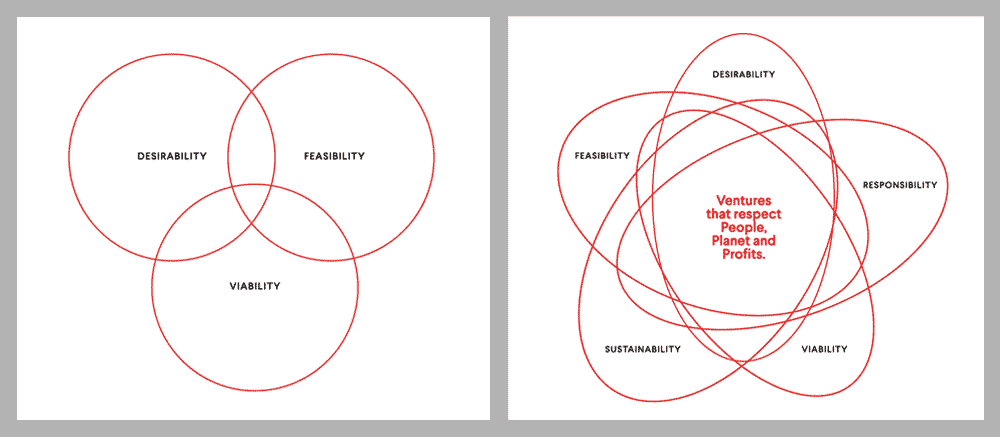
4. Ecosystem Mapping
Customer centricity, sadly, is a problem rather than a solution. We know enough today, this far into the 21st century, to understand that we are facing systemic problems as a global community, the likes of which the world has never seen before. Looking at all these problems, we need our best and brightest minds to work on equitable, inclusive, sustainable futures and bring them into existence within a rather short time span.
— Sebastian Mueller, Stop Being Customer Centric.
From racist and gender-biased AI algorithms to “surveillance capitalism”, the environmental impact of cryptocurrency mining, and the rampant rise of online misinformation and hate speech—the adverse impacts of digital products and services on people and the planet are increasing.
Digital product design generally focuses on target customers or users. However, compelling cases can be made for teams to consider all the stakeholders in an ecosystem. This could potentially help organizations create more equitable, responsible, and sustainable digital products, services, and programs.
Further Reading: Stakeholder Mapping: A Guide for Purpose-Driven Organizations
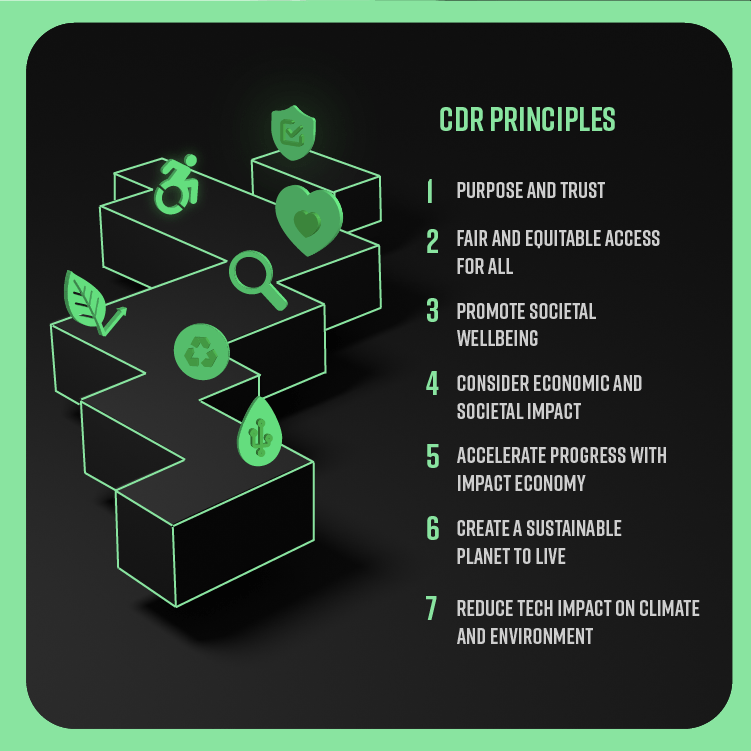
5. Corporate Digital Responsibility (CDR)
Corporate Digital Responsibility (CDR) is a set of practices and behaviors that help an organization use data and digital technologies in ways that are perceived as socially, economically, and environmentally responsible.
— The CDR Manifesto
Digital is no longer just the design or IT department’s responsibility. Digital products, services, and practices touch every department within an organization. For most forward-thinking organizations, it’s just how business is done.
Plus, the rapid growth of digital transformation—and the adverse consequences that can arise from it—require responsible, digital-specific governance practices. For example, think Corporate Social Responsibility (CSR), but specific to digital business.
Corporate Digital Responsibility can help organizations measurably improve the way they use and deploy digital technologies and the practices associated with them. As organizations expand their digital business practices, CDR will transition from emergent to must-have.
Further reading: Seven Core CDR Principles
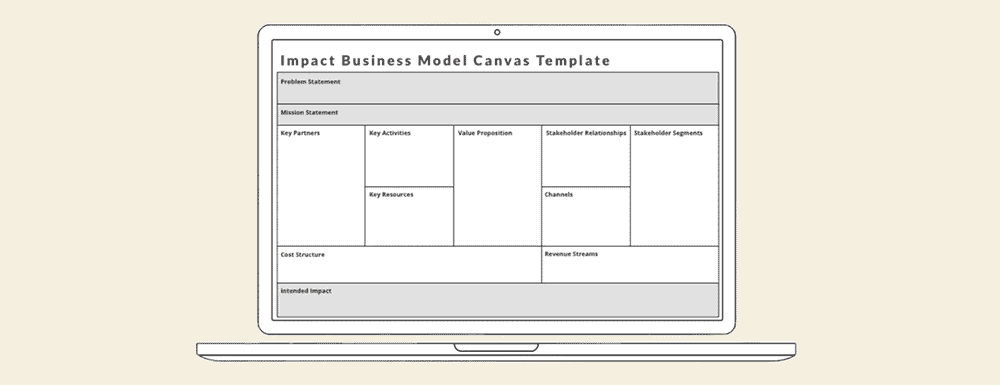
6. Impact Business Models (IBM)
Many for-profit companies earmark a portion of their profits each year for specific causes or individual nonprofits. While there’s certainly value in traditional corporate philanthropy, its siloed approach can be challenging.
Adopting an Impact Business Model (IBM) can help organizations operate more ethically and responsibly while also maintaining a profitable business model. B Lab, the nonprofit that certifies B Corps, weighs IBMs heavily in the B Impact Assessment.
What’s more, IBMs improve an organization’s ability to create impact, which is inextricably linked with its ability to generate profit. IBMs are not grounded in philanthropic “give back” programs. Instead, the business model itself drives both impact and profit.
Good IBM examples include:
- Fellow B Corp Greyston Bakery’s Open Hiring Model
- Chicago’s own Bright Endeavors, which provides stable, living-wage employment and training for young moms ages 18-24 to fuel the organization’s candle business
While IBMs aren’t specific to digital business, technology can help you implement one. At Mightybytes, for example, we incorporate green hosting, digital accessibility, and sustainable web design into our digital agency services to achieve a successful IBM.
Most nonprofits already have purpose-driven financial models. However, they can learn from the IBM approach as well. Relying solely on philanthropic funding can be unpredictable at best. Crafting programs that create impact while also providing stable sources of income can help any organization thrive.
Related content: Our Corporate Philanthropy Practices
Digital Business Trends: UX Design
Here are several UX design trends that could impact your organization’s products, services, or programs.
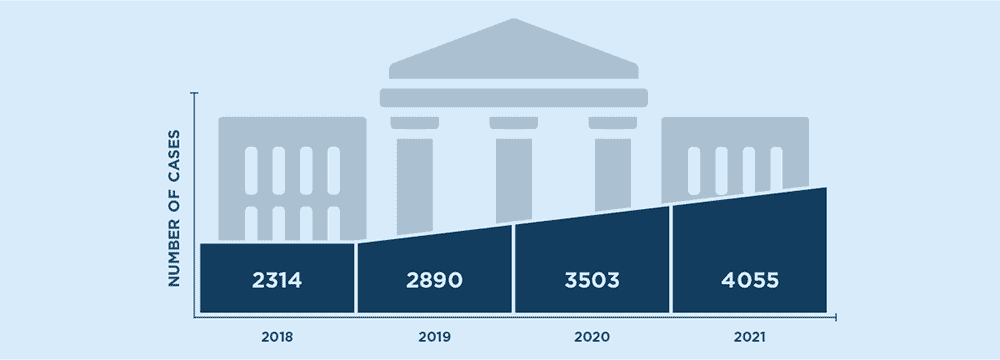
7. Accessibility & Inclusive Design
In general, people with disabilities tend to boycott organizations whose websites don’t meet their needs. This is a lost opportunity for most businesses. If one online retailer has an accessible website while another doesn’t, guess who the disability community is going to support?
— Charles Petroff, Access Living, Improve Your Company’s Inclusion Practices by Doing This
In their 2021 year-end report on ADA Digital Accessibility Lawsuits for websites, mobile, and video, UsableNet reported that the number of annual accessibility-related lawsuits against organizations for their digital products and services crested above 4,000 for the first time ever:
- Many organizations received more than one lawsuit.
- Organizations that sell anything online comprise 74% of these lawsuits.
- Many of these lawsuits list widgets and overlay features as barriers to equal access.
Up to one billion people worldwide identify as having some type of physical or cognitive disability. For some, lack of access to information, products, or services could be life-threatening.
Similarly, truly inclusive design must be grounded in diversity. In addition to ability, design processes must also consider race, sociocultural background, gender identity, age, sexual orientation, language, and many other factors.
With a 15% rise in digital accessibility lawsuits plus new content accessibility guidelines on the horizon, it is safe to say that digital accessibility and inclusive design should be priorities for any organization in 2022.
Further reading: What’s Next in Web Content Accessibility?
8. Mobile First (Again)
83% of people say a ‘seamless experience across all devices’ is very important.
— Intechnics blog
We’ve been writing about mobile first and responsive design for a long time now. The range of devices and screen sizes designers need to create content for expands every year. This adds complexity to the design process as product teams strive to provide useful experiences.
More importantly:
- As noted above, lack of access to information can potentially be life-threatening.
- Plus, more than half of annual website traffic comes from mobile devices/tablets.
- Also, Google prioritizes mobile-optimized content in search results.
- 70% of customers abandon purchases because of bad user experience. This costs retailers alone more than $2B in lost sales.
So, why are there still so many crappy mobile experiences on the internet? Budgets, timelines, inexperienced teams, organizational priorities—all play roles in how people’s needs are prioritized in the design process.
The reasons to rank mobile high in your design process are compelling and multifold. If you’re planning a website or product redesign in 2022, be sure to consider mobile alongside accessibility, sustainability, responsibility, etc.
Further reading: Mobile First Design and Sustainability
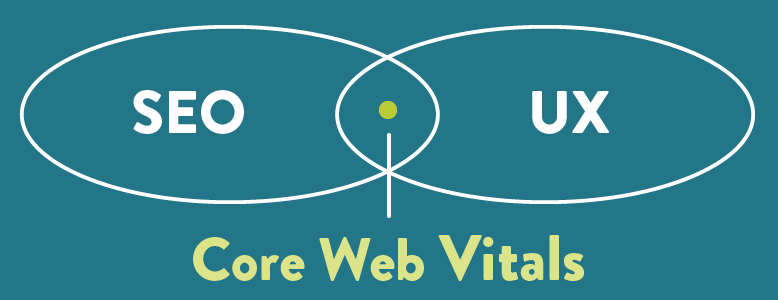
9. Core Web Vitals
The launch of Google’s Core Web Vitals in 2021 inextricably linked SEO and user experience (UX). Bad design choices that impede user experience now adversely impact search engine results on pages that employ them.
Organizations that prioritize SEO as part of their ongoing digital marketing efforts will need to ensure that choices like popup windows and embedded advertising don’t get in the way of providing a great experience for users. Users want fast-loading experiences that help them answer questions or accomplish tasks quickly. Be sure digital products and services provide this or accept the fact that your search performance may suffer.
Further Reading: Understanding Google’s Core Web Vitals

10. Sustainable Web Design
Moving to digital products may seem like a better, greener way to consume media—requiring less paper and transportation—but our digital technology use is now responsible for about 4% of global CO2 emissions and growing: As more people around the world move to digital forms of communication, with video projected to represent 80% of online traffic, that environmental impact will continue to grow.
— Christopher Marquis, Do You Know Your Virtual Environmental Footprint?
To account for the internet’s massive environmental impact, including its rising digital emissions, we need new design and development practices that center environmental conservation and sustainability principles. To that end, sustainable web design made big traction in 2022 and shows no signs of slowing down.
In fact, the HTTP Archive, which monitors the ‘state of the web’ saw fit to include a sustainability chapter for the first time ever in 2022.
Sustainable web design is characterized by a few key components:
- Lean and fast-loading web pages
- Renewable energy-powered green hosting
- Calculating emissions from digital products and services
- Better user experiences that remove barriers to information
These practices can help people measurably reduce their virtual environmental footprints while also improving user experience and performance.
Related reading: Sustainability Chapter of the HTTP Archive’s 2022 Web Almanac
Digital Business Trends: Technology
Here are several technology trends worth considering as you explore new digital products, services, or practices within your organization.
11. Interoperability
There’s a burgeoning, global understanding that the internet doesn’t have to be five giant websites, each filled with text from the other four…By changing the law to make it easier for users to walk away from Big Tech silos, we change what kind of technology can be built, what kinds of businesses can be operated, and what kind of lives digital users can make.
— Cory Doctorow, author of How to Destroy Surveillance Capitalism
You can’t leave Facebook but still talk to your Facebook friends. Similarly, you can’t switch from iPhone to Android and expect your apps to work. You also can’t port your iTunes library to Spotify or Kindle titles to other e-readers. This is all by design.
However, what if you could? What if you had the ability to port your personal data, apps, or media from platform to platform? There is a growing call for interoperability between platforms, for new services to plug into or piggyback on existing ones. Interoperability based on open standards empowers people to innovate, to collaborate, and to fulfill their own self-determination.
Frustrated by existing tech platform policies yet don’t feel you can leave? Emerging legislation that promotes interoperability could let you migrate to alternate platforms that actually care about their users. These might even be run by nonprofits or cooperatives versus public companies required by law to maximize short-term shareholder value (which can lead to big problems).
Further reading: The Future is in Interoperability Not Big Tech

12. Digital Resilience
Nearly 65% of companies were breached in 2022 as attackers exploited process gaps and security vulnerabilities to access networks.
— HelpNet Security, Attackers Evolve Strategies to Outmaneuver Security Teams
When digital products and services aren’t available or don’t work as intended, we put our organizations—and stakeholders—at risk. These risks often come from poor practices related to cybersecurity, accessibility, spam, data privacy, and other gaps in capacity, maintenance, or good organizational governance policies.
For example, every year, ransomware, phishing scams, website hacks, and other cybersecurity risks pose increasing threats to us all. Plus, as government agencies and larger companies shore up security measures to address these threats, small to midsize businesses (SMBs) and nonprofits—most of which are ill-prepared for these sorts of attacks—become new targets.
You probably don’t need another compelling reason to increase organizational resilience. For digital products and services, these threats are everywhere. There’s no better time to take action than right now.
Further reading: How to Improve Your Digital Resilience
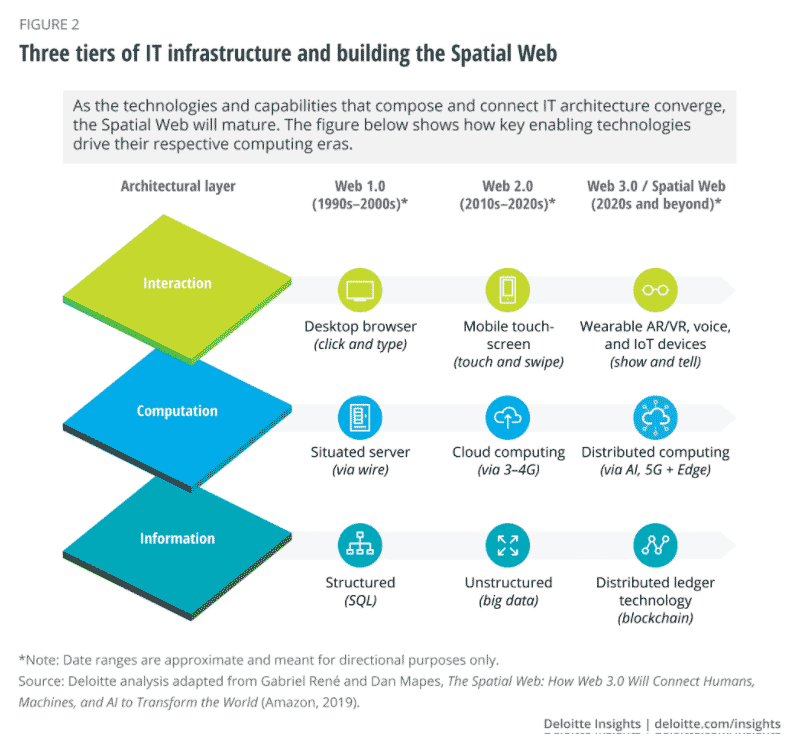
13. The Future of Web3
There is no single definition for Web 3.0, the computing era that follows our current, mobile-powered Web 2.0. Many people identify Web 3.0 with the Semantic Web, which centers on the capability of machines to read and interact with content in a manner more akin to humans. Recently, definitions of Web 3.0 have begun to include distributed ledger technologies, such as blockchain, focusing on their ability to authenticate and decentralize information. Theoretically, this could remove the power of platform owners over individual users.
— Deloitte Insights, The Spatial Web and Web 3.0
As blockchain, the metaverse, Internet of Things, and other technologies loosely associated with Web3 continue to mature, we must continuously monitor the role they play in the internet’s future and our own organizations.
This past year, frequent stories of hackers making off with millions of dollars worth of cryptocurrency, scams, outright financial fraud, and failed projects became the dominating Web3 narrative. All of this coincided with a massive and widespread cryptocurrency crash.
Should there be a financial market underpinning the majority of the internet’s core functions in the form of NFTs and Cryptocurrency? As it currently stands, the amount of bad actors and volatility of those markets make that an unappealing prospect.
Also, claims by some Web3 champions—who often made their fortunes in Big Tech—that they’re challenging Big Tech, and democratizing or “decentralizing the internet” are dubious, given the power and influence they wield in deciding Web3’s future.
However, none of this invalidates Web3’s usefulness to potentially create a better world. These technologies can and will be applied in ways that benefit society just as they have been used to harm.
Platforms like Mastodon, VR Chat and others imagine alternate futures that don’t rely on environmentally damaging technologies or Big Tech, so there is hope yet. The ideological battle for the internet’s future continues.
Further Reading: Web 3 is the Future, A Scam, or Both

14. Headless WordPress
WordPress’ market share is 43% of all websites.
— Kinsta, WordPress Market Share
Headless WordPress—the process of using WordPress’ API to create lightweight, static sites—can improve performance, cut down on page size, improve security, and dramatically reduce server requests, making for potentially happier users and a smaller digital footprint. We’re all about that.
With this approach, a website’s content database is decoupled from its display (hence the term “headless”). This provides more flexibility and the ability to scalably distribute your content across multiple channels—like mobile apps, social networks, websites, smart devices, or virtual assistants. To end users, it means faster digital products. Also good.
With all this said, a headless CMS setup isn’t for everyone. Since your content and its display are now separate, you have to manage multiple systems instead of just one. For organizations that publish a lot of content, this simply might not be viable. Plus, it requires teams with good front-end development skills in languages like JavaScript. Not every organization has those.
However, if you’re building multiple products with similar content needs and good performance requirements, headless WordPress might be for you.
Further reading: Headless WordPress, Explained for Beginners
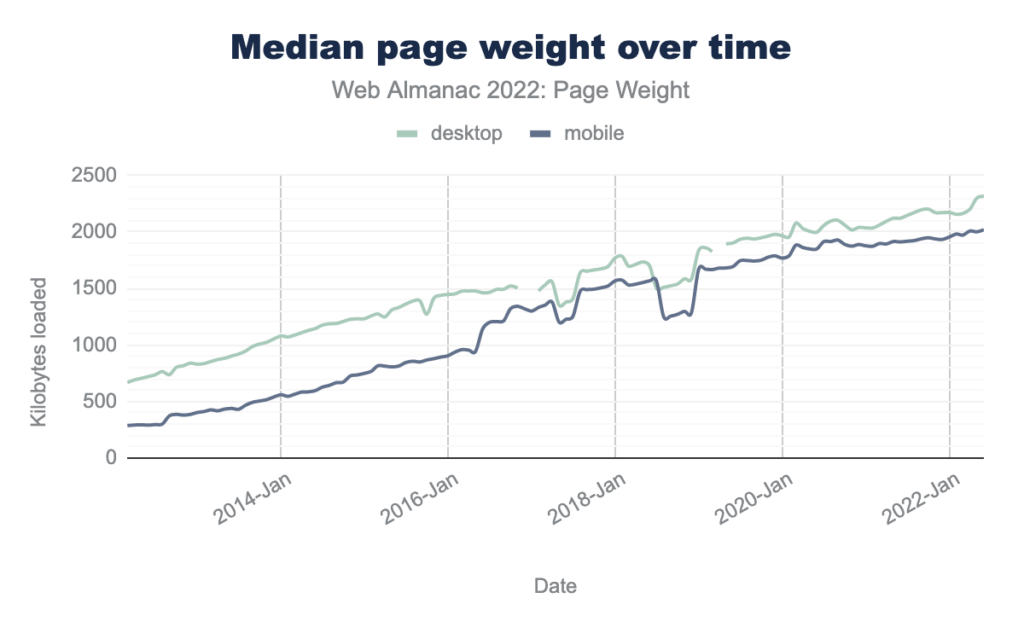
15. Prioritizing Performance (Again)
Page weight is not only important but arguably the most important factor affecting creators, hosting providers, and consumers…In the past decade, average web page weight has grown a whopping 356 percent, from an average of about 484 kilobytes to 2,205 kilobytes.
— John Teague, HTTP Archive Web Almanac 2021
Most of the internet is slow, clunky, and performs poorly. For those with high-end smartphones and high-speed connections, this might not be something you notice. However, if you live in an area with spotty internet connectivity, use an older device, or have a slow 3G or 4G data plan, this can cause serious problems and even put lives at risk during emergencies.
Poorly designed digital products and services often don’t consider the needs of all stakeholders (see stakeholder mapping above). Plus, over time, poorly managed digital products and services can accrue what is known as technical debt. Often, this manifests itself in poor performance: mobile apps don’t respond when they need to, pages don’t load or load slowly, and so on.
However, it doesn’t have to be this way. The fixes for poor performance are often simple, like compressing images, minifying code, or removing flashy (and heavy) video backgrounds.
It is critical that we create an internet that works for everyone. Prioritizing performance in our digital products and services is one way to do this. If you’re looking to improve your website, app, or other digital product in 2022, consider improving technical performance and existing functionality before pursuing new features.
Further reading: Technical Debt, Agile, and Sustainability
Digital Business Trends: Marketing
With so many marketing options available today, organizations can get stretched thin or focus their efforts on areas that don’t provide good returns. Here are several trends that could impact your digital marketing efforts this coming year.

16. Data Privacy (Again)
Societal choices about privacy will influence how political campaigns are run, how corporations earn their keep, the power that governments and private businesses may wield, the advancement of medicine, the pursuit of public health goals, the risks we are exposed to, how we interact with each other, and, not least, whether our rights are respected as we go about our daily lives.
— Carissa Véliz, Lit Hub
The reasons for prioritizing data privacy are compelling. Billions of online accounts have already been compromised by data breaches. Plus, millions of websites all over the internet already collect your personal information every day. In the wrong hands, this information could be used against you. We’re all at risk. So, what is a responsible organization to do?
Emerging legislation makes data privacy a bigger priority in many countries. While the U.S. lags behind Europe in enacting laws that protect people’s data privacy, the writing on the wall is clear: respect data privacy and give users control over their data—including when and how it is deleted—or face stiff penalties.
There are a world of things you can do to improve your organization’s data privacy efforts:
- Add an SSL certificate to your website
- Update your cookie and privacy policies
- Create practices for withdrawing consent
- Make payment gateways Privacy Shield-compliant
These are just a few examples.
Further reading: Download our Data Privacy Checklist for a more comprehensive list of things you can do.
17. Social Responsibility in Marketing
Although 31% of marketers say social responsibility is ineffective when it comes to campaign engagement or performance, 45% still plan to invest in it throughout the next year. Why? Because with the current state of things, social responsibility, ethics, and transparency matter to the modern consumer.
— Hubspot, The Marketing Trends of 2022
Traditional brands are finally learning what Certified B Corps, nonprofits, and other social enterprises have known for years: prioritizing social and environmental responsibility in marketing can drive community and bring many benefits across an organization’s value chain.
Socially responsible marketing saw a big uptick during the pandemic, which laid bare many inequalities in our economic systems and throughout society overall. By highlighting the good they do, companies can improve brand awareness and brand integrity. However, if the stories you tell aren’t matched with clear action, your socially responsible marketing efforts could backfire in catastrophic ways.
Related reading: 7 Pitfalls to Avoid in Your Sustainability Story
18. Media Misinformation
Even when the fight is an uphill battle, we must do the hard work of exploring what it takes to tell stories and share information rooted in truth. To build stronger institutions and confident, transparent leaders, we can’t become comfortable dabbling in partial truths. We must tell the whole truth.
— Justin Belleme, A Comprehensive Guide to Ethical Marketing
Misinformation and disinformation continue to run rampant on the internet. Both can negatively affect your organization. As social media and other external touch points become harder to control, many companies suffer a decline in trust:
- Customers for Kellogg’s and Warby Parker objected to programmatic ad placements on Breitbart.com.
- PepsiCo suffered an immediate drop and sustained depression of their stock price after disinformation about the company, including false quotes from their CEO, were spread online.
- And in February 2018, The Times discovered a number of household brands, universities, and charities were unintentionally funding terrorism, white supremacists, pornography, and other hate sites after advertisements were placed on their websites and next to YouTube propaganda videos.
Most importantly, maintaining (or reclaiming) customer trust should be at the top of an organization’s priorities when it comes to media misinformation. To support this, be prudent about your communication strategy and where content is being placed. Tips to protect your brand include:
- All content produced for your brand should be based only on facts.
- Use Google’s Disavow Tool to discount the value of bad links from external sites.
- In addition to your social accounts, you should audit the affiliate partners that promote your brand on their own network.
- The risk of partnering with an affiliate or influencer with a huge following might seem advantageous. However, it might not be worth misrepresenting your brand and you should associate only with credible partners and networks.
Further reading: Impact of Fake News on Digital Marketing, Amon Fearon on LinkedIn
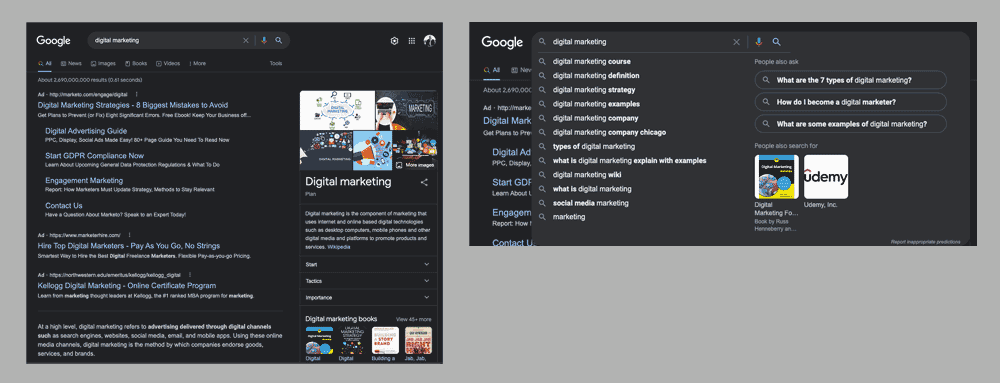
19. Contextual Search
Search has evolved a lot over the past few years. Contextual search provides users with a more efficient and hopefully more relevant search experience. Knowledge panels and other search components attempt to provide direct answers to search queries versus the traditional list of ads and clickable links.
Contextual search results use various parameters, including the search terms, geographic location, search history of the computer being used, and user attributes.
As in traditional SEO research, to determine how search engines use contextual search, start with a search. This should provide some insight into how a search engine attempts to answer a user’s question. Search engines with contextual results use semantic technology, artificial intelligence, and natural language processing to return personalized search results.
Organizations can take advantage of contextual search by adding structured data to their websites. Structured data has been around for a while. However, many organizations still don’t take advantage of it.
Search engines use company-specific structured data to determine which results to display. Website content is still written for your specific target audience. However, adding structured data to a post is like adding a separate language that provides information about a page and classifies the content. By using structured data, your content can be read and better understood by search engines.
The message here is clear: To perform well in search engines, create content that solves target user problems and employ structured data across your site.
Further reading: Why You Should Use Structured Data
20. Personalization & Automation
Companies that fail to show customers they know them and their buying preferences risk losing business to competitors who are more attuned to what their customers want. And the ranks of those competitors are growing. In a new survey of more than 600 business executives by Harvard Business Review Analytic Services, 47% say their organizations are already executing tailored customer communications successfully across all channels.
— Harvard Business Review, The Age of Personalization
Smart Content, aka adaptive or dynamic content, allows companies to tailor messages in emails, ads, and webpages to individuals based on their behavior, and increases engagement with users. Properly implementing a successful personalization program requires a few things:
- Planning: Your efforts must be properly resourced with the capacity for long-term success.
- Understanding: You need to clearly understand who you’re trying to reach and why.
- Insights: Do you have the right amount of data from those you’re trying to reach? If not, how do you get it?
Also, companies must be mindful of how data is collected and used in order to maintain trust with customers and comply with data privacy laws.
Marketing automation software is available for a variety of these tasks: email marketing, lead generation, social media posting, ad campaigns, etc. Companies often struggle with audience data collection and data management. Automation software allows marketing departments to work more efficiently, while providing a more personalized experience for customers.
There are a variety of automation tools available to meet your marketing needs. A consolidated list can be found in Neil Patel’s post, Marketing Automation: What is it, Examples & Tools.
The better the relationship between brand and customer, the more likely people are to share personal information, including email, location, preferences, and so on. This data is paramount to a successful personalized marketing strategy.
An online survey conducted in 2018 of 1,000 consumers aged 18-64, found 80% of respondents are more likely to do business with a company that offers personalized experiences and 90% find personalization appealing.
Further reading: A Guide to Personalization Marketing
21. E-A-T Your Content Marketing
Because it lacks a quantifiable metric and cannot be measured, the concept of E-A-T is a perpetual challenge in SEO.
— Search Engine Journal, 10 Content Marketing Trends to Watch in 2022
E-A-T, which has been around since 2014, is one of many guidelines Google recommends content creators use to ensure high-quality standards. It includes three components:
- Expertise: Does the content creator know their stuff?
- Authoritativeness: Are the website, its content, and creator authoritative on the topics they cover?
- Trustworthiness: Are the content, website, and creator trustworthy sources?
Essentially, this means that articles and other content should be created with a journalistic level of professionalism. Posts should be fact-checked, resources cited, editorial guidelines followed, and ideas presented with clarity to help users better understand topics conveyed.
However, because E-A-T is a set of content guidelines and not necessarily quantifiable via specific metrics, it might be challenging for digital marketers who focus on the more technical aspects of SEO.
While E-A-T isn’t new, it continues to remain relevant for content creators in 2022 for a few key reasons:
- Online disinformation continues to increase.
- Google continues to include information on E-A-T when they make core algorithm updates.
- AI-powered automated content generation tools are on the rise, yet they don’t necessarily generate top-tier quality content.
Related reading: Improve Content Consistency with Editorial Guidelines or How Story Structure Improves Content Marketing
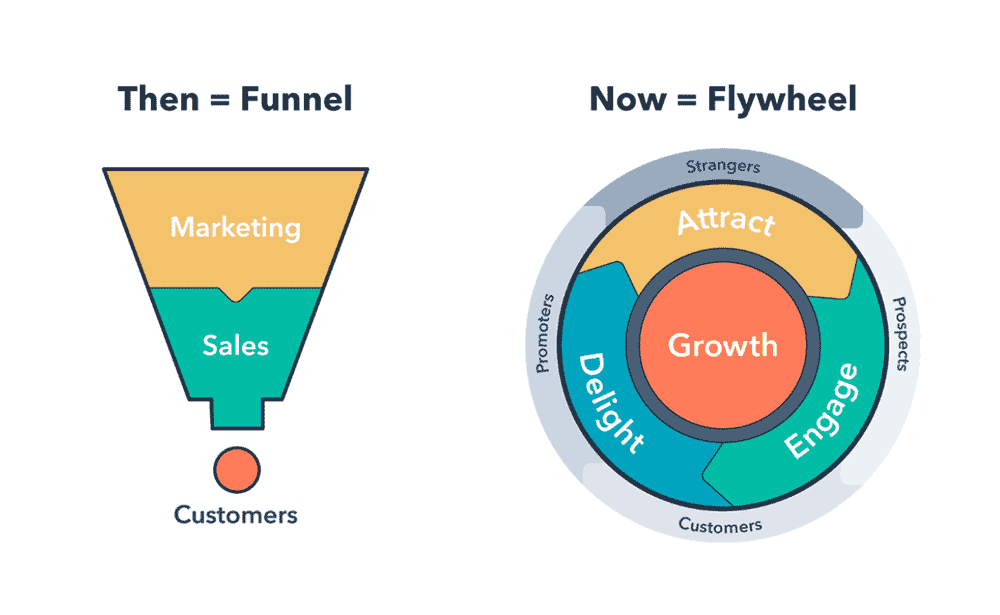
22. Flywheels Over Funnels
Today, customers are skeptical, knowledgeable, and have bigger expectations than ever before. And one of those expectations is that businesses should care about more than transactions. When companies make short-term decisions that sacrifice long-term relationships, compromise their values, and mislead, customers use their influence to share that information quickly and widely.
— Hubspot, How the Flywheel Drives Customer Growth and Delight
When designing sales or marketing strategies, many organizations employ a traditional funnel approach:
- Awareness: A potential customer learns about your brand for the first time.
- Interest: The prospect becomes interested in your organization.
- Desire: The prospect becomes a warm lead who is interested in your products or services.
- Action: They become a customer by taking some sort of action, such as purchasing a product or service.
First, funnels are linear, meaning there’s an inevitable dead-end. Plus, customer service, customer experience, and customer engagement are left out of the mix, undermining an organization’s chances for repeat business and customer loyalty. This is a significant missed opportunity.
Some funnels also include a step for retention. However, the funnel is generally a very incomplete approach to defining customer value.
Enter the flywheel. By creating cyclical processes and removing friction in internal customer service and experience you get happier, more engaged customers. If your customers are also advocates because they have a rewarding experience with your brand, they are more likely to provide word-of-mouth referrals, the most powerful form of marketing.
Because of this, flywheels can help you identify the biggest chances for growth within your organization. Not sure how to identify those opportunities? Start with a customer journey mapping workshop to identify touch points in the customer experience and where customers might be feeling anything other than delighted.
Further reading: What is a Customer Journey Map? [Free Download]
Digital Business Trends: Closing Thoughts
Design, technology, and marketing change quickly. Each change impacts the business strategies you need for success. What’s a “best practice” today could be outdated tomorrow.
In this post, we shared 21 different digital business trends that are most relevant to our purpose-driven work with clients, in the B Corp community, and as a digital agency based in Chicago. We also left out dozens more. If you’d like to discuss any of the items in this list, please drop us a line. We’d be happy to start a conversation.
Digital Carbon Ratings, now in Ecograder.
Understand how your website stacks up against industry carbon averages with this new feature.
Try Ecograder


